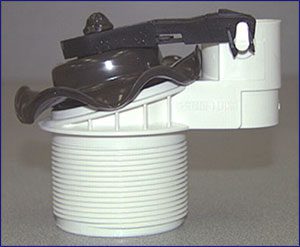Leaking toilets cause more water waste than any other fixture in the home. Even a silent toilet leak (that’s one you normally can’t hear) will waste from 30 to 500 gallons of water per day!
The ones you can hear will waste much, much more. Such wastage can normally be attributed to a faulty water level adjustment or to a leaky flapper.
Leaky flappers and the “dye test”
Most people will say their toilet does not leak. There is one sure way to find out. Put some food dye in the tank and then leave for 15 minutes. When you return, look into your bowl to see if there is now dye color in the water spot. If there is color, or if you already can hear and or see water running in your bowl, it’s time for a new flapper!

Deformed flapper valves are often the result of toilet tank cleaning products.
After installing the new flapper, run the dye test again to assure you have no leak. If the leak persists (and every now and then it will), you are probably going to have to replace the entire flush valve.
“It only runs in the middle of the night”
Many toilets really do run only at night; that’s because people use much less water during these hours and in many municipal water systems, the water pressure rises considerably during this time.
It is not uncommon for system water pressure to rise by 15 to 20 pounds per square inch (psi), and by as much as 30 psi in some situations. This rise in pressure could cause “water creep” inside your gravity-fed tank by 1/2 inch or more. That is why the manufacturers of toilets normally suggest that the water level to be set at approximately one inch below the top of the overflow tube.
Water level in the tank
If you only notice your toilet running in the middle of the night, there is a good chance that the water level in your tank is set too high. Click here to learn how to adjust the water level in your toilet tank.
Use your water meter to check for leaks
For information on how to use your water meter to detect toilet (and other) leaks, click here.
- If You Have No Hot Water Pressure, Here’s What You Should Do - December 28, 2021
- What is the Right Shower Drain Pipe Size? - January 25, 2020
- Wet Vent Plumbing, What Is It? How Do You Utilize It? - November 17, 2019

